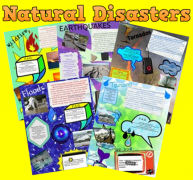This lesson is for : Grade 3:
Summary
This cross-curricular project is a result of collaboration between teachers, weather expert, and students. It is uniquely designed to support the research, writing, and communication goals of diverse students. Students with various background knowledge extend their familiarity, develop perspectives, and evaluate a global problem: Natural disasters. The students’ cumulative project, an interactive poster, is being shared and analyzed by others.
Through internet research students build background knowledge. They share new facts and observations in Google Doc. They then form questions and interview a weather expert. Students relate their gained knowledge in a new way by creating a radio broadcast script, rehearsing for fluency, and recording their voices. Differentiation is implemented in this portion by the students having assigned roles; one having several written options to choose from, one receiving sentence starters, while two require complete planning and implementation. In addition, students apply their knowledge of natural disasters by writing a narrative chapter for their group’s book. For differentiation purposes, one group mate is responsible for the table of contents, glossary, and captions while the the other three are writing a story from the perspectives of his/herself, an emergency responder, or the storm itself.
In the end, included on the students’ Glogster poster are learned facts, a narrative chapter book published through Windows Movie Maker, radio broadcast recorded through Audacity, and thoughtful response to the question, “How does your natural disaster affect human, animal, and plant life and why is it important to be prepared?” that is being analyzed by others.
TIPC Ratings
Research & Information Fluency
Rating: Ideal – Explanation: This project falls in the Ideal/ Target range. Students used several online resources to build onto their prior knowledge of their assigned natural disaster. This included both text and videos from multiple websites as selected by the students. They made observations of these video clips and recorded learned facts in their own words. In addition, the students used research through a weather expert. The weather expert Skyped the class, offering meteorology information and answering questions created by the students. Students were able to display information fluency through a variety of modalities including a narrative writing piece, radio broadcast, and text boxes. These doubled as authentic assessments as both language and content knowledge were displayed.
Communication & Collaboration
Rating: Ideal – Explanation: This project falls in the Ideal/ Target range. The teacher designed this project to incorporate communication in a range of ways. Students communicated verbally in both a social and academic setting as they worked to reach agreements and display knowledge. They also experienced long-distance video communication, as Skype was used to communicate with a meteorology student at Virginia Tech. Students collaborated digitally using their Google Drive accounts as they researched their natural disaster, wrote a news broadcast script together, and published their writings into one book. Furthermore, students used selected digital tools, such as Glogster, Audacity, and Windows Movie Maker to relay their research and creative writing to their peers through their final project. The final project was viewable to all students of the school and became an opportunity for those students to build background knowledge, vocabulary, and use critical thinking to evaluate the effectiveness of the debate to answer the question, “How does the natural disaster affect human, animal, and plant life and why is it important to be prepared?” Communication and collaboration was a highlighted feature of this project as it was a unique opportunity for the regular education, SPED, and many ESL students to lower their affective filter through differentiation, while meeting their own personal academic and social goals through speaking, listening, reading, and writing. The teacher was able to ensure that each student was involved in these forms of communication by questioning individuals and groups throughout the tasks. In addition, students evaluated themselves on their communicative goals and reflected on their strengths and weaknesses through the use of a student-friendly rubric after receiving feedback from others via Google Form.
Critical Thinking & Problem Solving
Rating: Ideal – Explanation: This project falls in the Ideal/ Target range. All levels of Bloom’s Taxonomy questioning were displayed in this project. Students even asked their own pre-planned questions to a meteorology student at Virginia Tech via Skype. Writing and recording a weather radio broadcast through Audacity required higher level thinking. They also needed to apply their new information in a creative way. However, one of the most prominent examples of critical thinking lies in the question, “How does the natural disaster affect human, animal, and plant life and why is it important to be prepared?” that was answered by each group in an effort to convince readers of its destructive state. It will be necessary that students understand the effects to gain a worldly understanding of devastation caused. The students were able to reflect on their and their peers’ responses with two separate self evaluations while making goals for future growth.
Creativity & Innovation
Rating: Ideal – Explanation: This project falls in the Ideal/ Target range. Each group displayed creativity through the voice and uniqueness of their narrative writing piece. Group members wrote from different perspectives to create a cumulative chapter book to tell one big story. In addition, the students had to design a natural disaster radio broadcast. Moreover, the cumulative interactive poster showed much individualism and creativity. The manner in which this information was displayed to other students showed great innovation.





